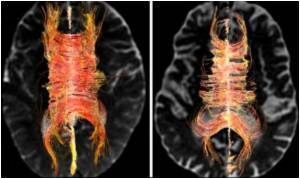Researchers used the D279R kinesin mutant to prevent abnormal axon growth. They transfected the mutant β3-tubulin into dissociated embryonic neurons, which reduced axonal growth.

Some of the β3-tubulin mutations in CFEOM3 have been linked to microtubule interactions with kinesins--proteins that use energy to move from one end of a microtubule to the other.
"Our original aim was to understand the molecular mechanism underlying kinesin-tubulin interaction in the pathogenic mutants," explains lead author Itsushi Minoura. "Surprisingly, the kinesin mutants that we created effectively rescued kinesin motility and axonal growth, even in live mice."
The team began looking at the role of a specific amino acid location on β3-tubulin called R262, because the R262 mutation is the most common mutation in patients with CFEOM3. Using a recently developed baculovirus-insect cell-expression system, they first found that in vitro, this mutation does indeed inhibit the ability of kinesin--specifically the kinesin KIF5B-- to move along microtubules formed from β3-tubulin. In fact, the kinesin would not even bind to the mutant microtubules.
The team reasoned that if they knew what part of the kinesin interacted with the microtubule, they could then look for kinesins with mutations at that location, and perhaps find one that was able to move along the R262 mutant microtubules. The crystal structure of the kinesin-microtubule complex indicated that β3-tubulin binds to kinesin KIF5B at location D279. After several experiments, they found what they were looking for: replacing D279 with another amino acid--making a D279R mutant--allowed the kinesin to move along β3-tubulin microtubules with the R262 mutation.
Next, researchers tested whether they could use the D279R kinesin mutant to prevent abnormal axon growth in cultures neurons. They transfected the mutant β3-tubulin into dissociated embryonic neurons and as expected, saw significantly reduced axonal growth. They then found that neurons co-transfected with both mutants grew a normal length, and the abnormality was successfully suppressed.
Advertisement
Notes Minoura, "while the rescue experiment is not available for humans, understanding the roles of the many types of tubulin in normal mammalian brain development is an important step towards understanding the pathogenesis of many neurodevelopmental disorders such as lissencephaly and polymicroglia."
Advertisement
Source-Eurekalert










